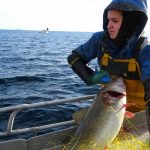NOAA has revised the fishing closure in the oil-affected areas of the Gulf of Mexico. This will be effective on May 21, 2010. All commercial and recreational fishing including catch and release is prohibited in the closed area; however, transit through the area is allowed. According to the press release of NOAA this revised closed area is bounded by rhumb lines connecting, in order, the following coordinates: From the point where 30°01′ N. lat. intersects with the 3 nautical mile Louisiana state boundary; proceeding southeasterly to the point 29°50′ N. lat. and 88°14′ W. long.
Thence easterly to the point 29°50′ N. lat. and 87°28′ W. long.; thence, southeasterly to the point 29°27′ N. lat. and 86°31′ W. long.; thence southwesterly to the point 28°48′ N. lat. and 87°0’ W. long.; thence, southeasterly to the point 28°07′ N. lat. and 85°01′ W. long.; thence, southerly to the point 25°35′ N. lat. and 85° 01′ W. long.; thence, southwesterly to where the point 25°13′ N. lat. intersects with the outer Federal water boundary; thence northerly along the boundary to where the point 86°16′ W. long. intersects the outer Federal water boundary; thence northerly to 26°48′ N and 86°20’ W; thence northwesterly to 28°40′ N and 91°0’ W; thence northerly to the point where 91° W. long. intersects with the 3 nautical mile Louisiana state boundary; thence along the seaward limit of Louisiana’s waters.
The release states that the closure measures 48,005 sq mi (124,333 sq km), which is just under 20 percent of the Gulf of Mexico exclusive economic zone. The majority of federal waters in the Gulf of Mexico are open to commercial and recreational fishing. NOAA Fisheries Service strongly advises fishermen not to fish in areas where oil or oil sheens are present.








